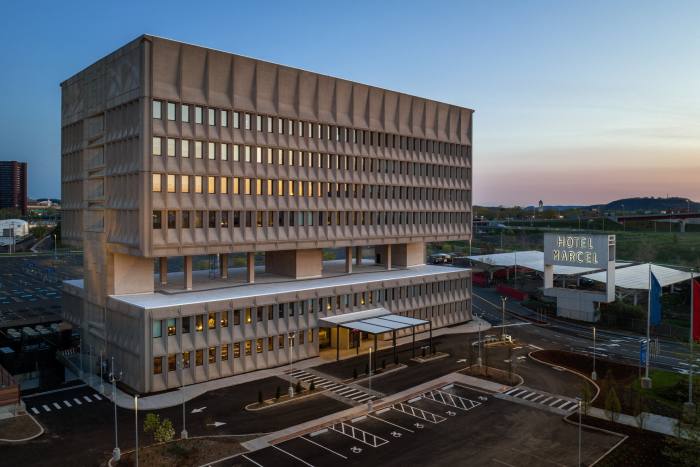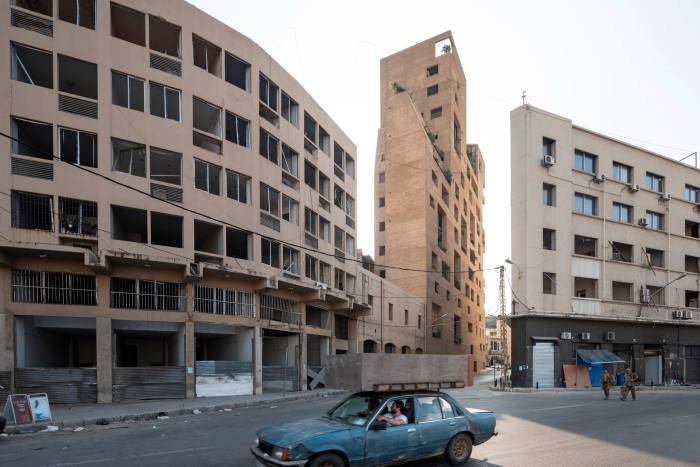During the peculiar interlude of the pandemic, architecture was one of the least disrupted of the cultural industries. Construction carried on, yet in many cases there were few people around to see the results. Unable to hold off any longer and committed with staff and schedules, cultural institutions, hotels, stores and whole neighbourhoods opened with only local audiences to catch them. Here is my Christmas list of tantalising places I missed but hope to visit in the near future.
M+, Hong Kong

Hong Kong’s massive museum of art and culture, this Herzog & de Meuron blockbuster opened to a deafening global silence in November 2021. Yet this might well be their finest building, a modernist plinth and slab set into the rock and against the water. Since its conception and design, the political and cultural situation in Hong Kong has radically shifted and the agenda with it, but I’m still very much looking forward to what promises to be Asia’s most intriguing new museum.
Hotel Marcel, New Haven

Marcel Breuer’s striking brutalist HQ for the Armstrong Rubber Company stood sentry at the entrance to New Haven, Connecticut, an empty, largely unloved monument, a modernist version of a ruined medieval castle. Latterly revived as a strange Ikea outlet, it has now been repurposed by architects Becker + Becker as a hotel. In its new incarnation as an exquisite example of adaptive reuse, it is paying penance for its years as an auto-parts manufacturer by being billed as a “net zero” building.
The unlikely success of Breuer’s former Whitney Museum in New York as a temporary home for the Frick has shown just how adaptable these solid concrete landmarks can be and this is another stage in accepting the notion that we should be cherishing good modern buildings and not demolishing them. New Haven, despite the wealth of Yale, can be a down-on-its-luck kind of town, but this looks a terrific project.
Neue Nationalgalerie, Berlin

An exact contemporary of Breuer’s late-1960s building, this museum by another Bauhaus émigré, Ludwig Mies van der Rohe, remains a gallery after its extensive refurbishment by British architect David Chipperfield. Mies van der Rohe holds a special place in the hearts of architects and this building shows off both his brilliance and his obstinacy. A glass box of almost unimaginable clarity, its appearance might lead a visitor to say, yeah, great, but where’s the art?
The insertion of art would, of course have sullied the transparency and the plan while all that natural light would have damaged the paintings, so Mies buried them in the basement. Problem solved. It is a building that perfectly encapsulates minimal modernism’s paradoxes, its obsessions with exquisite detailing, with purity and the expression of openness. After half a century, it had begun to seriously deteriorate. Restored by Chipperfield (who remains more of a national treasure in Berlin, where he also revivified the ruin of the incredible, scarred Neues Museum), this is one of those buildings architects have always fetishised despite its obvious faults. I shall be fetishising as soon as I can.
Taipei Performing Arts Centre

Long anticipated, this radical-looking megastructure sitting alongside Taipei’s buzzing night market looks like a kind of Death Star but is, in fact, a machine for expanding the city’s cultural life. Designed by Rem Koolhaas and OMA, it is a flexible arts space of the kind envisioned, but never quite built, by the avant-garde architects of the 1960s and, arguably, by their Soviet constructivist forebears in the 1920s. With performance spaces able to expand and contract within the building and with public life able to spill out into the city, it looks a remarkable project. It has its UK equivalent in Manchester’s Factory, by the same architects, which looks strikingly unlovely but may yet surprise.
Z33, Hasselt

The small Belgian city of Hasselt has managed what many bigger cities have attempted and failed to do: to become a cultural destination through architecture. The newest piece in its puzzle is Italian architect Francesca Torzo’s incredible looking Kunsthalle for Z33, an institution that merges art, design and social concerns. Torzo has inserted a building between a former beguinage (complex for lay religious women) and an existing museum.
Ca’n Terra, Menorca

Spanish architects Ensamble seem to have done very little to this Menorcan former stone quarry. The forms were already there, carved out of their stone and, with only the lightest of touches, the architects have reimagined these cool subterranean spaces as a dwelling in the rocks. More ambitious and less light-touch, a network of abandoned quarries in China’s Jinyun county have been repurposed as cultural complex by architects DnA_. With narrow canyons and cavernous halls, these returns to the earth seem unsettlingly contemporary.
Rebuilding Beirut

The shocking explosion at Beirut’s docks in 2020 hit just as the world was emerging from Covid lockdowns. But Beirut is nothing if not resilient and its rebuilding has been by turns shocking, corrupt, outrageous and brilliant. Architects including Lina Ghotmeh (currently designing next year’s Serpentine Pavilion in London) and Youssef Tohme have been designing remarkable new buildings with an energy and approach that seem unique.
Sydney Modern

Japanese architects Sanaa have been responsible for some of the most sublime museums, including the radically minimal Louvre Lens, which sets out the history of art as a landscape to be surveyed in a glance. In Sydney their sprawling new gallery tumbles down a hillside overlooking the harbour. It looks mightily impressive, but also less controlled than their usual work.
Reshaping Paris
Paris mayor Anne Hidalgo is achieving remarkable things, not without controversy. Chief among them are plans to make the city more amenable to pedestrians and cyclists. The most ambitious is a plan to remake the Champs-Élysées as a long public space rather than a traffic artery.
In the meantime, she has also instigated a series of architectural hotspots around transport hubs, each containing significant elements of social housing. Jean-Christophe Quinton’s scalloped social housing built in place of a demolished police station in the Sixth Arrondissement is an elegant throwback to Paris’s historic blocks. Even the revered La Samaritaine on the Seine has been reimagined by Japanese architects Sanaa with subsidised housing as a part of it. Paris is often condemned as the archetypal doughnut city, forcing its poor to the edges, but at least it is trying.
Venice Architecture Biennale
After an odd Covid year with sparse crowds and no parties in 2021, the Biennale is bouncing back with Scottish-Ghanaian curator (and architect and novelist) Lesley Lokko, and promises an optimistic view of the future with an emphasis on Africa. Venice seems the perfect venue for this global rethink and Lokko’s energy should be a breath of fresh air.
Plus: three things I am not looking forward to
Smithfield Market
Only in London would a market with a thousand-year history be forced out of the historic centre. While other cities cherish the life, the grit, the hubbub and the mess made by markets as critical contributions to the continuity of real life, London has been desperate to turn its markets into themed destinations and tourist hubs. Smithfield’s particular focus on bodies, Barts hospital, the meat market and the sweaty clubs full of writhing dancers are what keep it an organic piece of real city. The end of the market is the end of a neighbourhood and an era.
NEOM
A part of me is thrilled by the idea of a visionary, sustainable city, a sci-fi vision of existence in an increasingly harsh climate. The rest of me groans each time I see the vacuous PR for this insane project in Saudi Arabia. The 100-mile city in a desert trench is production design, not architecture or urbanism, a world of PR superlatives and headlines. Like the “tallest tower in the world” in Jeddah (“currently on hold”), it is a thing brought into being as a headline not responding to genuine need. It will be started and abandoned and perhaps its ruins will be discovered in the desert a thousand years from now and celebrated as the mad folly of a suicidal civilisation.
The last of the postwar City
When the City of London was rebuilt after massive bombing in the Blitz, it was conceived as a modernist place studded with fragments of emerging archaeology and its few surviving Edwardian offices, all surmounted by a pedway system allowing people to walk above the traffic in between crisp architecture. It was never an unalloyed success but it remains a fascinating moment which threw up some superb modernist buildings, most of which have now been demolished to make way for clunky and oversized monoliths. Bastion House is among the crispest and best and, with its fragment of pedway, should be preserved.
Stay connected with us on social media platform for instant update click here to join our Twitter, & Facebook
We are now on Telegram. Click here to join our channel (@TechiUpdate) and stay updated with the latest Technology headlines.
For all the latest Art-Culture News Click Here
